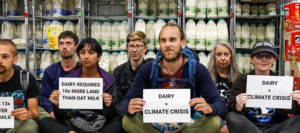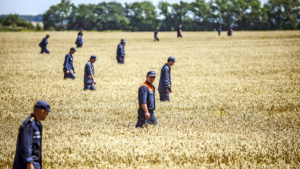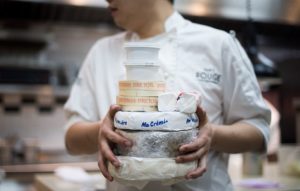Jean-François has two hectares of vines in our valley in South-West France: his family have been making wine here on this hard limestone soil for more than half a century. And yet, he would like nothing more than to grub up his vineyards. If you ask him why, he looks skywards, and then, with hands as gnarled as his vines, pulls out the lining of his coat-pocket. Vide. Empty.
The nectar of the gods, French wines have a reputation for being cultivated in a sun-kissed vineyard surrounding a honey-stoned chateau, owned by a Hollywood star like Leonardo DiCaprio, or a Gallic aristo whose family escaped the guillotine. Jean-François is neither. And he is not the only vigneron who is struggling. Things are far from rosé for France’s small winemakers, as two hundred militants made clear outside the Prefecture in Bordeaux one Thursday last month. They follow the thousand who protested in the city last December, when vignerons hung a human effigy outside the doors of the Bordeaux Wine Council, to raise awareness for grape-growers at risk of suicide. “Every day there is a suicide in agriculture,” Didier Cousiney, president of the Viti 33 collective informed the crowd.
In the Bordeaux area alone, 500 vignerons are looking in the bottom of the glass and seeing financial ruin. And you can add to these the growers nearing retirement who cannot find buyers for their vineyards. Like Jean-François. In the Medoc, land prices are actually sinking.
Jean-François would like to simply abandon his vines. He cannot, because it is illegal. Abandoned vines are vectors for disease, which can spread to other vineyards. Vines must be either cultivated or grubbed up. But grubbing costs €2,000 per hectare, money Jean-François does not have.
Crisis in the French wine industry affects more than viticulteurs. In France, wine is not merely a drink: it’s a national symbol, the liquid affirmation of l’Art de vivre à la française. If you opened the arteries of Marianne, you would find them coursing with a Bordeaux Appellations d’Origine Contrôlée, the official certification for wine grown in the geographical region and made with requisite skill. Until 1981, French children were allowed to drink wine in school. So, when the wine industry turns sour, France’s identity suffers a hangover.
As does its income. Wine is France’s second biggest export after aircraft, worth about €15 billion a year according to the Fédération des Exportateurs de Vins et Spiritueux de France (FEVS).
What’s going wrong in the vineyards of La Belle France? Jean-François’s eloquent gestures indicate some of the causes. Doubtless French winegrowers have been complaining about the weather since the Gauls planted the first native vines in the fifth century BC. But in the last five years, the weather has lurched from one Biblical extreme to another. We’ve had drought, which did for my own few vines last year; we’ve had flooding; we’ve had hailstorms. A late frost in April 2021 affected 80% of the nation’s vineyards.
Such was the desperation of viticulteurs then that vineyards were heated overnight with candles and paraffin heaters, to keep the frost off the delicate buds of the fruit. The sight of the vineyards of Bordeaux, the sacred centre of the French wine industry, lit by geometrically exact lines of candlelight was magnificent, but the image ultimately came to symbolise the powerlessness of humans in the face of Mother Nature. After le gel historique, there were few climate change deniers in Bordeaux’s vineyards. According to the European Environmental Agency, France is suffering the biggest economic losses caused by climate change of any country in the world. The Hexagon took a hit of €4.2 billion in 2020 due to climate change.
Merlot is the crucial grape variety of the Bordeaux region, making up 60% of the area’s vineyards. It will be the first wine grape to show the impact of climate change. “The flavour of French wines will be more alcoholic, less acidic and less aromatic,” Agnès Destrac-Irvine, of Bordeaux University’s experimental VitAdapt vineyard told Time magazine in 2020. In other words, Bordeaux Merlot as the world knows and drinks it is facing extinction.
Jean-François grows Merlot.
But it is too easy to see the issue as simply one of supply. Since 1998, Italy has often outranked France to be the globe’s number one producer of wine — last year, Italy produced 50.3 million hectolitres, compared to France’s 44.2 million hectolitres — and it is not unknown for France to fall behind Spain in terms of volume. This fall from the gold position in terms of quantity may irk Gallic pride, but France’s real problem is that it cannot shift the stuff it does produce. There is an issue with demand. Take the Bordeaux region: it produces about 480 million cases a year, yet sells only 440 million cases, and much of that is flogged off at knock-down, bargain-basement price.
Why won’t it sell? This state of affairs is largely home-grown because — sacré bleu! — the French are drinking less wine (with the exception of champagne), and exports are insufficient to cover the gap. In the Fifties, the average French adult drank 150 litres of wine per year, about half a bottle a day. Wine, especially red wine, was the beverage of choice for lunch and dinner. Industrial workers would have a “rouge” in the bar tabac before clocking on at the factory, and farm workers a few sips throughout the day to keep warm in the fields.
But according to a report published by the Kantar Institut last year, the French have reduced their consumption of red wine by 32% since 2011 alone. Wine consumption per person in France is now dipping below 40 litres per year, and some 38% of the French never drink wine at all. In fact, France is one of the fastest-growing markets in the global boom in alcohol-free drinks.
The reasons are numerous, but generational difference is key. Among retirees, wine consumption is barely changed: people in their sixties and seventies grew up with wine on the table at every meal. For them, wine remains part of France’s patrimoine, or cultural heritage. But they are, in the way of all flesh, dying off. And, some argue, failing to induce wine appreciation in the young. Those between 18 and 35, meanwhile, are more likely to be drinking water at the table, and beer at the bar (beer accounted for 39% of the expenditure on alcohol among French people aged under 35 in 2021. Wine just 27%.)
Denis Saverot, editor of La Revue des Vins de France magazine, blames “our bourgeois, technocratic elite with their campaigns against drink-driving and alcoholism, lumping wine in with every other type of alcohol, even though it should be regarded as totally different”. French TV and cinema is currently running a government message not to toast health — “Sante!” — with alcohol since alcohol is unhealthy. (“La bonne santé n’a rien à voir avec l’alcool”.) Official messaging is working: according to a poll by the Ifop institute, 27% of French people intended to participate in Dry January this year, although you’d be hard-pressed to find one of them in a French winegrowing region. Nicolas Carreau, president of the Blaye Côtes de Bordeaux appellation, told regional daily Sud-Ouest, “we are for limits and reasonable consumption”, but “Dry January contributes to smashing our culture”.
But looking at the sorry state of the industry, an older French wine-lover might experience déja vu. Because the sector has been in crisis since the Sixties, what with the decline in drinking and the rise in New World wines. What saved French wine last time was China.
Pouring into the market for Bordeaux after the 2008 global financial crisis, Chinese consumers soaked up the flood of plonk that no one else wanted. But no longer. French wine shipments to China dropped by nearly 30% in 2022, a shift led from by the elite: the CCP, as part of its anti-corruption drive, has instituted rules on the amount that can be spent on alcohol at state functions.
And it’s not just wine they’ve stop buying. For the decade after 2011, the Chinese were the top foreign investors in Bordeaux vineyards, buying around 170 chateaus. Now they are only conspicuous by their absence, following capital controls by Beijing intended to keep domestic currency within China’s borders, and sustain the yuan. (The failure of Chinese managers to understand the French worker’s absolute commitment to a max 35-hour week did little for harmony in the vineyards.) Symbolically, the gates of the Chateau de Grand Branet, owned by Chinese conglomerate Dalian Haichang Group, are locked with a rusty chain.
Other major markets for French wine are also turning up their noses at the stuff. The UK has been successfully wooed by the cheap, easy-drinking wines of Australia, South Africa, Chile and Argentina. More to the point, British wine is booming. And the French — incroyable! — are investing in it. Henkell Freixenet, Pommery and Tattinger have all bought vineyards in southern England. America, meanwhile, has implemented tariffs and discovered it has no taste for the bottom half of Bordeaux’s production barrel, although it remains an outlet for “fine wines”.
But for how long? To offset the decline in domestic consumption, French winemakers niftily moved upmarket during the 2010s, selling expensive wine abroad — the Saint-Emilions, the Margaux, the premiere cuvées. This shiny wine bubble, which diverted attention from the structural problems in the industry, has now burst, courtesy of inflation and the cost-of-living crisis. Winemakers’ hopes of forever increasing the price on the label have a firm cork in them.
The French wine industry may be over a barrel, but it is not dead yet. Some winegrowers are shifting wholesale to eco-friendliness. By 2025, 100% of winemakers in Bordeaux will have some form of organic or sustainable certification, or be transitioning towards getting one. This is a good bet, since the data on French wine consumption when mined suggests that remaining drinkers are looking to buy better wine, and are more “engaged” with their choice.
Meanwhile, the bigger chateaux have already diversified into wine tourism —which, pre-pandemic, was welcoming more than 24 million enthusiasts every year. Certain destinations are enhancing the experience with some of the most expensive art installations in Europe: Provence’s Château La Coste has pieces by Louise Bourgeois and Tracey Emin, plus a “railcar” sculpture by Bob Dylan. (Yes, that Bob Dylan.)
All well and good, but no salvation for small wine producers like Jean-François in the here and now. They are calling on the French government to subsidise the pulling-up of vines in Bordeaux’s less prestigious areas to the tune of €10,000 per hectare, with about 10,000 hectares going to the digger. Officially, member states of the European Union are prevented from releasing funds for grubbing-up, but never underestimate the French ability to fudge and evade the rules. (The European Commission once memorably allowed France leeway on its budget “because it is France”).
The vignerons also have expectations of President Macron, a celebrated, self-avowed oenophile who drinks two glasses of wine a day, one with lunch and one with dinner. The Revue du Vin de France named President Macron “personality of the year” in 2022. He picked up his award in person, telling the audience: “You are the masters of an art which allows us to shine around the world.”
While my neighbour Jean-François waits for the politicians, he continues to prune his vines under the grey skies of Southwest France. He is gritting his teeth, preparing for another year of financial loss. Another bitter harvest.
Disclaimer
Some of the posts we share are controversial and we do not necessarily agree with them in the whole extend. Sometimes we agree with the content or part of it but we do not agree with the narration or language. Nevertheless we find them somehow interesting, valuable and/or informative or we share them, because we strongly believe in freedom of speech, free press and journalism. We strongly encourage you to have a critical approach to all the content, do your own research and analysis to build your own opinion.
We would be glad to have your feedback.
Source: UnHerd Read the original article here: https://unherd.com/







